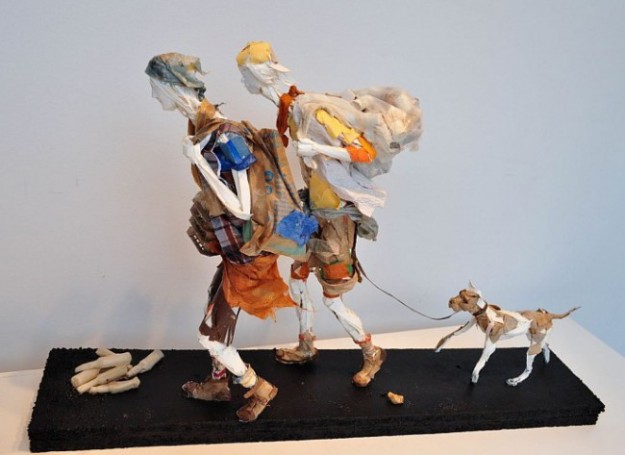It was with much publicized disgust that Montreal mayor Denis Coderre last month denounced the “anti-homeless” spikes that have recently appeared outside downtown businesses. Coderre appeared shocked by the violent measures Montrealers are taking to eradicate homelessness – for their own benefit. Montreal native Ivan Markovic, on the other hand, uses art to tell the story of Montreal homelessness, rather than trying to erase it with spikes. His latest exhibition, “On the Fringe,” filled Montreal’s Galerie D’Este with distinctive paper sculptures, representations of the homelessness in Montreal.
A Concordia University graduate, Markovic previously found success in March 2013 with his show “Shades of Isolation” which also featured homelessness as the subject of his sculptures. “Fringe,” while continuing to explore homelessness, focuses more broadly on those which Markovic described to The Daily as living “on the fringe […] people who choose to opt out, don’t want to participate in society the way it is set up, and who want to live an alternative form of life.” For Markovic, “opting out” can mean “homelessness, travelling the world on a bicycle, living off the grid – there are many possibilities.” In particular the way that many people who are homeless seem to be “living in a kind of limbo or a bubble with no exit,” provided metaphorical power to these outsiders that he felt any audience might be able to identify with.
Out of combinations of paper, smatterings of wire, copper tubing, and copious amounts of glue, Markovic has created evocative figurines of homelessness. The sculptures are stylized with pale elongated limbs and clad in rumpled, falling-apart clothing. Many are accompanied by their dogs, or grasp what few possessions they own: books, paintings, a bicycle. In one sculpture scene, a pair of bedraggled lovers run hand in hand from a storm. In another, an itinerant musician carries his elaborate stringed instrument to his next impromptu concert.
The use of paper as the primary material is strikingly suited to the theme of fringe city life, being both everywhere and nowhere at once. After all, if there is anything more synonymous with modern city streets than homelessness, it is surely the discarded scraps of paper that litter them. This is a far cry from the pristine origami wildlife that we usually associate with paper sculpture, the paper instead evoking the nature of the urban environment. The dozen or so sculptures are also accompanied by an array of similar sketches displayed on the surrounding walls; however, they ultimately lack the visual power and presence of the sculptures.
But for all the presence the sculptures possess, it is unlikely that they can change or influence the mainstream stereotypes of homelessness. When Dorothea Lange’s photographs of the poverty endured by Depression-era farm labourers affected those on the other side of the country who saw them, their effective power existed precisely because the viewers lived on the other side of the country. Montrealers, on the other hand, already encounter homelessness everyday.
That said, putting homelessness so blatantly on display in a gallery gives those who would normally walk right by a rare opportunity to stare at and absorb its simulacrum. Markovic himself has found that part of the reason his previous work has resonated with audiences, is that people are already concerned about those who have found themselves on society’s edges. “People experience this on a day to day basis, going to work or just going about their daily activities they see people who live on the fringe,” he explained, “and on a certain level they do […] feel they are somehow related in that they share the same environment; they are part of their lives.”
Like Lange before him, Markovic portrays his subjects with dignity, selecting titles such as Artist, Reader, and Scavenger of Lost Worlds. However grounded in reality the figures may be, though, they also posses an otherworldly quality. The arresting essence of these figures is an aesthetic triumph, indicating a clear intent beyond simply documenting ‘the fringes,’ and toward considering the metaphorical and symbolic qualities of existence on society’s edge. The care Markovic takes in observing and representing homelessness makes it clear that, despite the aesthetic focus, he doesn’t have a romanticized conception of his subjects or their lives. Indeed, far from objectifying those on the fringe, Markovic’s work may actually subjectify them, in trying to allow his audience to reach their own conclusions.
As far Markovic’s own conclusions, the artist is optimistic about his city’s actions on homelessness, spikes aside. He is “proud to be a Montrealer […] in the sense that we are doing a lot: in my neighbourhood alone there are five missions […] that’s just in the Berri area, yet so much more can be done.” Perhaps shows like “On the Fringe,” if not as representative as real interactions with homelessness on the streets of Montreal, may still cause one or two more passers-by to stop and look around.

